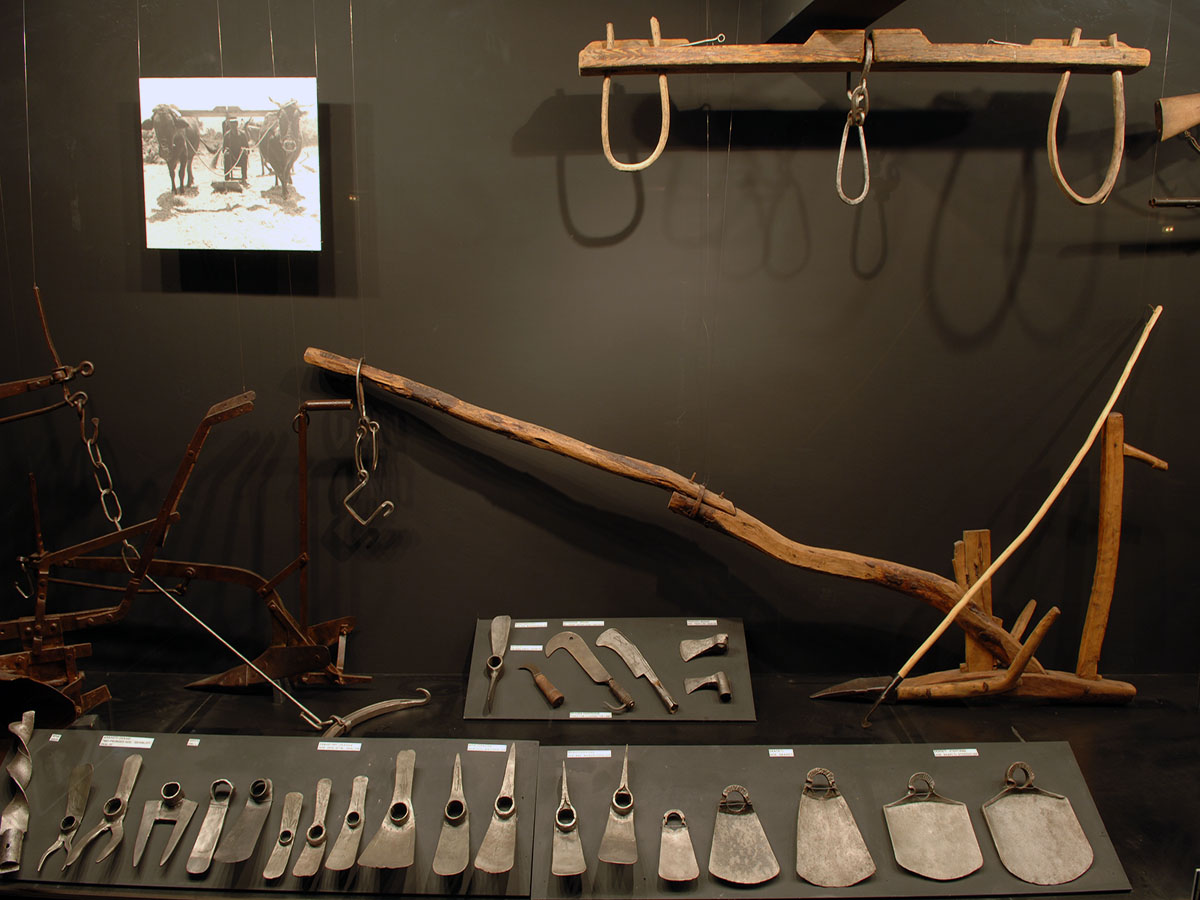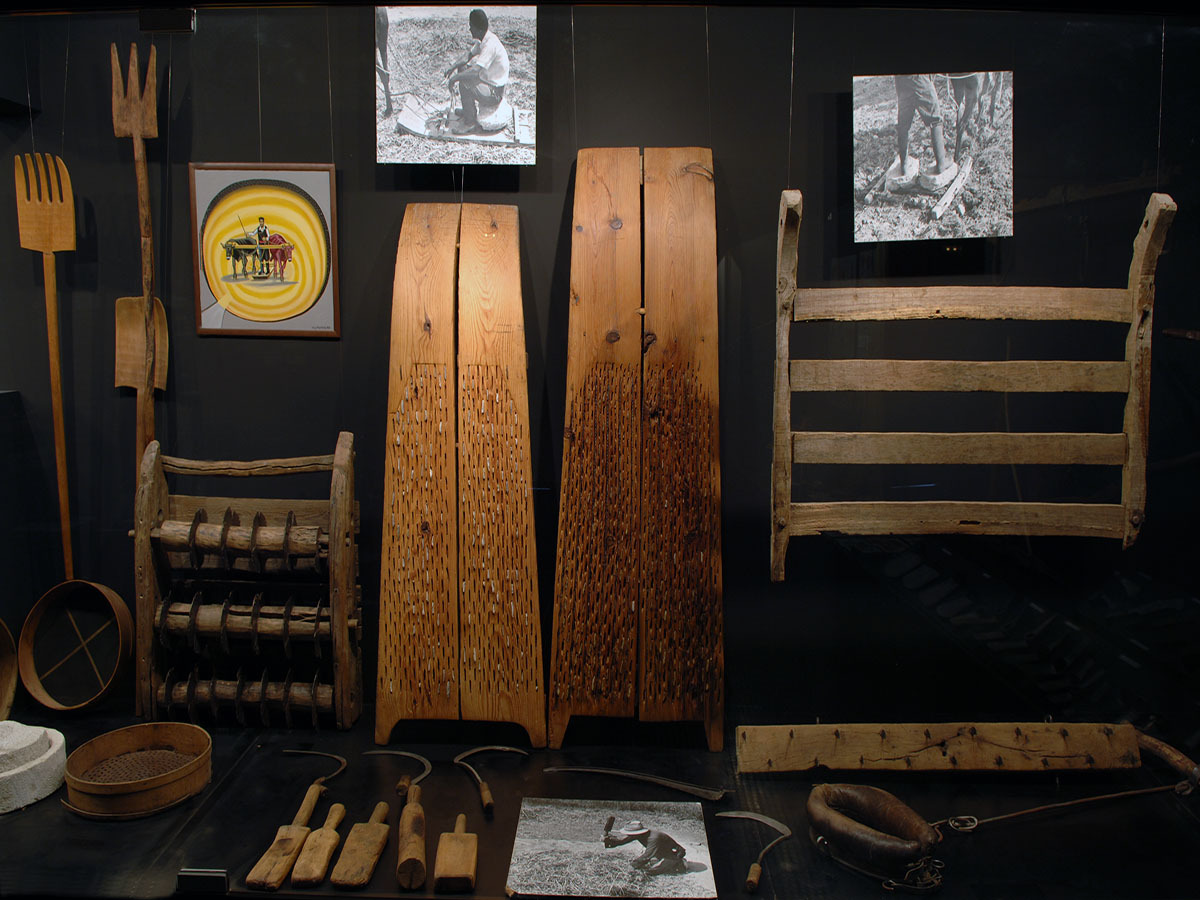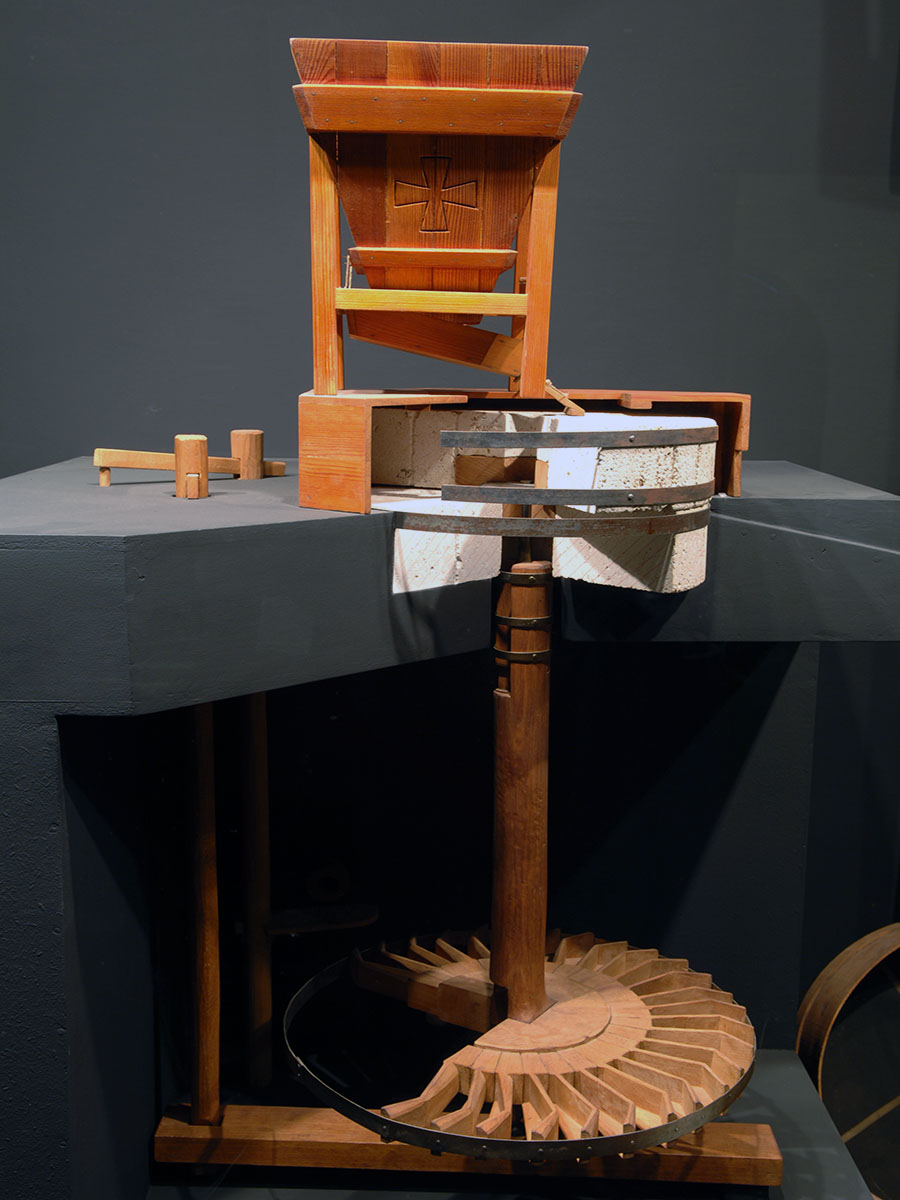Exhibition
Presentation Of Exhibits By Section
Agriculture
Agriculture is a necessary occupation of all rural dwellers, whether farmers or fishermen, herders, craftsmen etc., as agricultural produce forms the staple diet.
Various tools are used for the various forms of cultivation, and some have remained unchanged since Neolithic times, i.e., about 10,000 years!
Ground preparation and tilling implements
The ground must be cleared before cultivation. The most commonly used tools are axes and saws for felling trees and various hoes, spades and billhooks for shrubs and bushes.
Once the land has been cleared, it must be tilled in preparation for sowing or planting. There are many types of hand tools, from the mattock to the hoe. When a large area of land is to be cultivated, a plough drawn by animals must be used, speeding up the process and tilling the soil to a greater depth.
Ploughing
The type in use across Crete was “Hesiod’s plough”, a wooden plough with the main share cased in metal. This plough was used from time immemorial until its abandonment in the 1950s. Three types of metal plough produced in Central Greece at the end of the 19th century began to be imported to Crete, especially after the liberation of the island in 1898.
The simplest type is called “diftero” (double ploughshare) and is a smaller imitation of the wooden plough.
The second type is called “ monoftero ” (single ploughshare) and has a wide, tall and stable share on the right-hand side for deep tilling in good soil.
The third type is the rotary plough. This also has a large share, but it rotates on an axis and may be placed to left or the right of the plough, as its name implies.

Supplementary ploughing implements
In Crete, the wooden plough is always drawn by two cows attached to a large yoke. Each tip of the yoke has holes for the zevles, U-shaped wooden or metal rods attached to the cows’ necks.
The ploughman uses a long-pointed goad with a metal tip on the blunt end, to encourage to cows to move faster and to clean mud off the ploughshares.
Metal ploughs, which are small and relatively light, are usually drawn by a single donkey or, more rarely, a mule. The animal wears a kaso, a thick leather collar, to which a small wooden or metal yoke is attached by thin chains.
Sowing And Harrowing
Cereals and other seeds are sown before ploughing, on land which in autumn may be covered in weeds. However, the plough covers most of the seeds with earth and they germinate in 10-15 days.
After sowing and ploughing, the fields are harrowed to break up lumps of earth and push the seeds deeper. Various implements are used, such as the “ xyloporta ” (wooden harrow) and its metal counterpart, the “ svarna ”, a heavy wooden beam with metal points underneath. Implements to level the ploughed soil is drawn by a single plough-animal, while the cultivator sits or stands on the harrow to weigh it down.

Harvest
Once the cereals and legumes (wheat, lentils, beans, peas etc.) are ripe, they are harvested with a special sickle. This has a relatively short, wide blade and a long, heavy handle, and breaks the stalks without cutting them. This type of sickle was chosen because plant stems are particularly tough in hot, fertile lands. In north-western Europe, sickles have long, thin, sharp blades because the stems are thin and easily cut, due to heavy rainfall and low temperatures.
Threshing
There are many implements intended to separate the grain or fruit from the husk or stem, depending on the species and local custom.
The ears of cereals are placed on the threshing-floor, a large, flat, circular construction on a height where the breeze blows. The stems are separated from the grain using a strong “sledge” made of two boards studded with stone spikes, which crush the stems and husks. The threshing-sledge is drawn by two cows or other beasts of burden. These sledges are called “ volosyroi ” in Crete, and the knapped stone spikes may indicate that their use dates to the Neolithic period. In Western Europe they are known by their Latin name of tribulum.
Another light threshing-sledge, the “ alonistra ”, has three thick, rotating wooden cylinders underneath, each shod with six sharp metal bands which separate the seed from the stems. This implement is used in western Crete and was described by Napoleon’s surveyors in Egypt in the late 18th century.
Legumes such as lentils, chick-peas, beans etc. are threshed on the threshing floor using the “kopanos”, a short, flat and heavy wooden flail.
Winnowing
Three hand implements are used for this process:
* The “thrinaki” is a wooden three-tined fork with which the threshed cereals are tossed into the air when it is windy. The heavier grain falls to the ground while the chaff is blown away.
* The “palami”, a wooden shovel, is used to pile the grain in the centre of the threshing-floor and load it into sacks.
* Sieves with different sizes of hole depending on the plant are used for the final separation, chiefly for legumes.

Milling
Certain types of grain are milled into flour for bread, pita pastry and other foods.
The handmill , composed of two circular stones of which the upper is rotated by hand, is one of the oldest implements of the Neolithic period, used for milling wheat, barley etc. Handmills were found until recently in all rural households in Crete as a secondary implement for milling flour when necessary.
The mechanism of the watermill was invented by Greek engineers in Alexandria about 2,000 years ago. Its use gradually spread throughout the Mediterranean and Northern Europe, and from Russia to the Caucasus. The mechanism is composed of two large millstones, the upper rotated by a shaft bearing a horizontal or vertical paddlewheel activated by running water.
The windmill is used when there is no water available. Its mechanism is the same as that of the watermill, but the superstructure with sails is driven by windpower.
Both these types of mill have a high output and are found across Crete. Cretan families used to grind grain for bread (2/3 barley, 1/3 wheat) once a month. They baked enough loaves to last a month, cut them into slices and baked them into “paximadi” rusks which kept for a long time.
